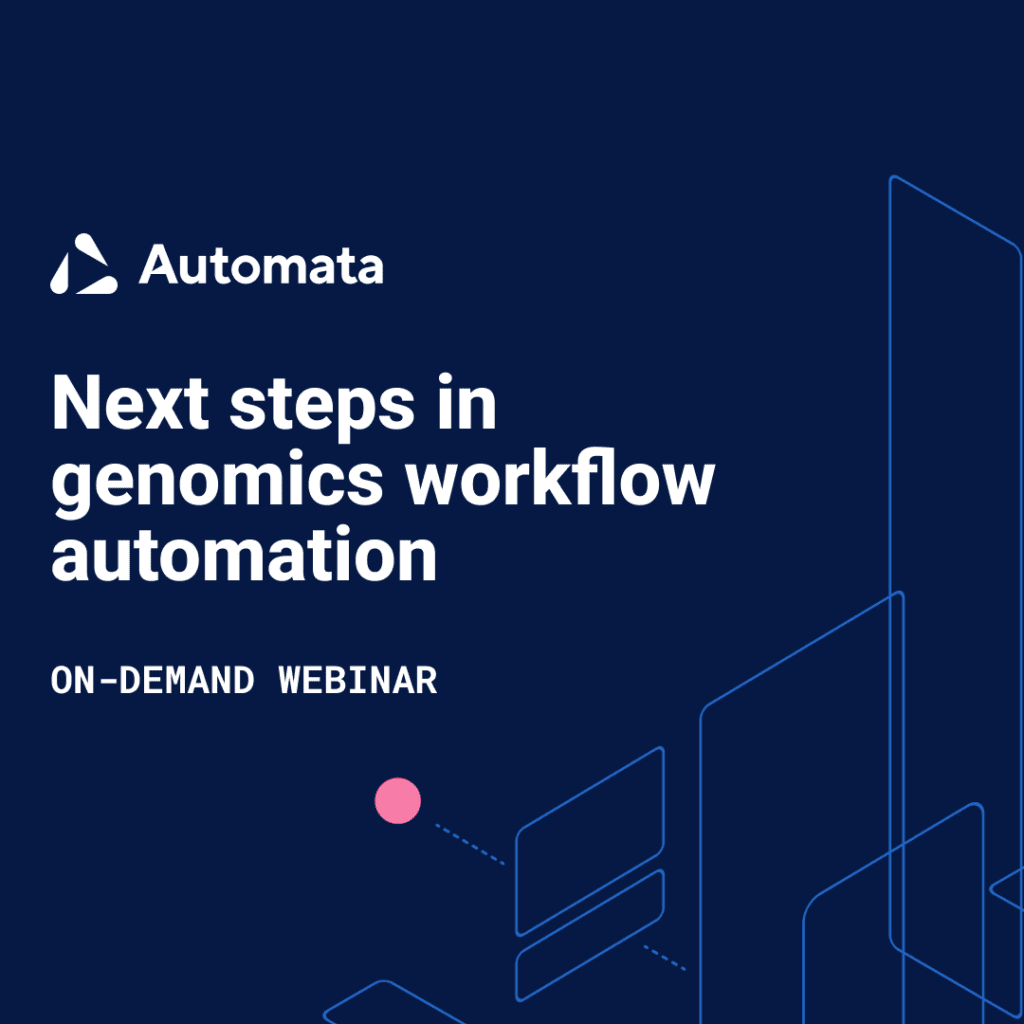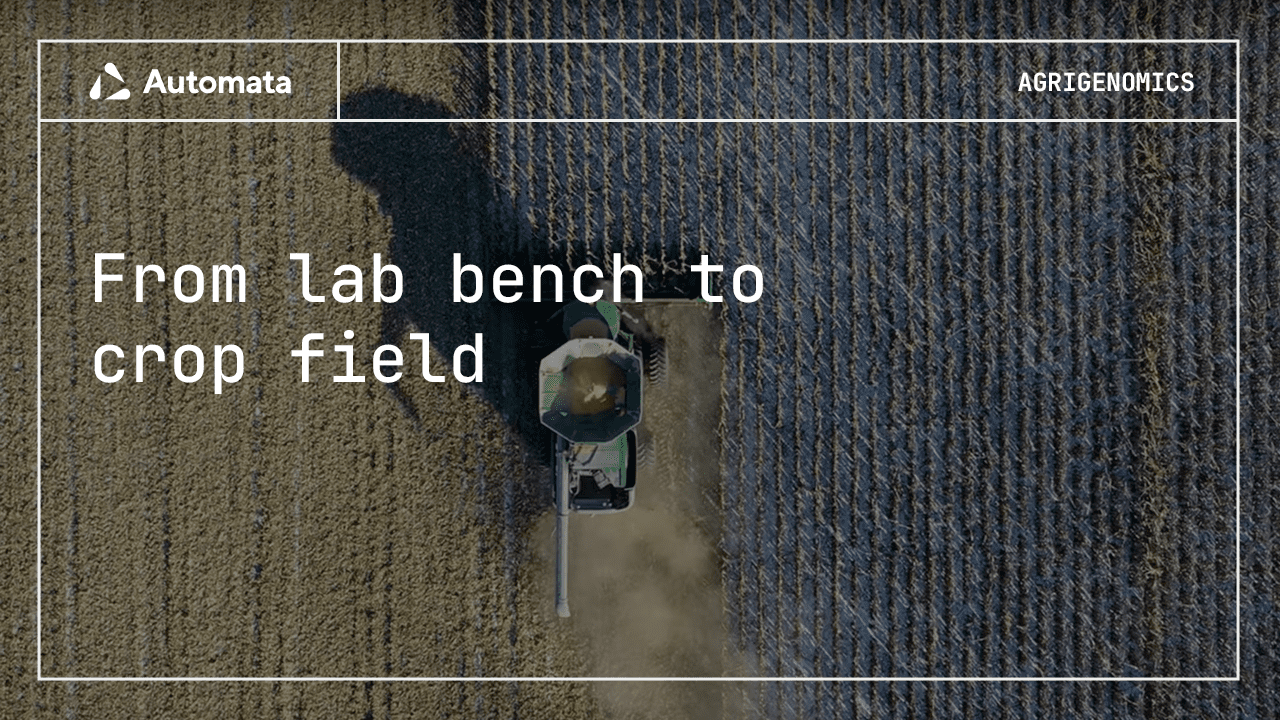Genomics is transforming the future of agriculture. Learn how open, integrated automation solutions can drive innovation and results at scale.
What is agrigenomics?
Agricultural genomics, commonly known as agrigenomics, is the application of genomics within the agriculture industry to improve productivity and sustainability in crop cultivation and livestock breeding practices.
It employs advanced genomics technologies such as next-generation sequencing (NGS) to help researchers, farmers, and breeders identify the genetic markers behind desirable or undesirable traits, informing decisions on cultivation and breeding processes.
Agrigenomics is an emerging field with transformative potential amid the environmental uncertainty and food insecurity brought about by a growing population and climate crisis.
What are the applications of agricultural genomics?
Agrigenomics encompasses numerous applications with critical importance for human, animal, plant, and environmental health. Some of the primary applications include:
- Crop improvement: Genomic information can be applied to understand the genetic basis of crop yield, disease resistance, drought tolerance, and other desirable traits. This information facilitates the development of novel, genetically modified crop varieties with improved, advantageous characteristics 1.
- Livestock improvement: Similarly to crops, genetic information about livestock populations can be used to select desirable traits such as improved milk yield, growth rate, meat quality, and resistance to infection and disease 2.
- Microbiome studies: Understanding the microbiome of the soil or the gut of livestock can give insights into plant health and livestock digestion and metabolism that can further improve agricultural outcomes and contribute to better plant and animal health.
- Biofuel production: Agrigenomics can provide insights into metabolic pathways and genes to optimise biofuel production, an increasingly in-demand renewable energy source 3.
- Traceability: Agrigenomics can be employed to trace the origin of animal products. For example, the genetic makeup of a particular batch of crop or meat can be matched to its source, ensuring authenticity and quality.
- Biodiversity and conservation: Agrigenomics can enhance our understanding of the genetic diversity among crops and livestock, paving the way for improved conservation efforts 4.
Why is agrigenomics important?
Agrigenomics is crucial not only for those involved in the agricultural industry but also for the wider population. It provides the potential to improve the quality and yield of crops and animal products, which will continue to be increasingly important as the challenges of a growing global population and the food insecurity presented by climate change mount 1,2,5.
Its ability to improve sustainability in agricultural processes and accelerate biofuel production will be paramount as the climate crisis progresses and the demand for renewable energy sources grows 3.
Another knock-on effect of climate change is the alteration of ecosystems and habitats, leading to biodiversity loss 6. On the other hand, the loss of carbon sinks, such as rainforests and peatlands, contributes to intensifying the effects of climate change. Thus, by better understanding biodiversity and accelerating efforts to restore it, this positive feedback loop may be slowed 4.
Aside from enhancing environmental health and food security, agrigenomics applications in microbiome studies and traceability can lead to better health outcomes for animals and humans. By providing genetic information, scientists can better understand the genetic basis of disease in animals and plants and develop strategies to evade it, fostering better animal and plant health which has a knock-on effect on the quality of the foods we eat 1.
The benefits of open, integrated automation in agrigenomics
Agrigenomics is a growing field of research with a pressing need for scalability as the need for food security and environmental sustainability grows in line with the growing population and urgency of the climate crisis. Thus, this area stands to benefit considerably from open, integrated automation solutions such as Automata’s LINQ platform, which presents several considerable advantages for genomics in agriculture 7,8.
Scalability and efficiency
Open, integrated automation can streamline processes and reduce manual tasks in genomic research 9.
For example, automated DNA extraction and sequencing can process large numbers of samples quickly, consistently, and reproducibly.
Recently, Automata partnered with The Francis Crick Institute to automate their sample library preparation as part of NGS and genomics workflows.
Similarly, Automata’s solution for automating quality control in genomics workflows helped one lab to reduce their setup time from 370 minutes to just 15 minutes, and their manual touchpoints from 1388 to 7. This could easily be applied to agrigenomics applications enabling more efficient, scalable, and cost-effective processes.
Data integration
An open platform enables the integration of data from different sources to be integrated. In agrigenomics, genotypic data (e.g. DNA sequences) could be combined with phenotypic data (e.g. information on crop yield, disease resistance, or animal growth rates). Integrating data in such a way facilitates comprehensive analysis and improved decision-making towards the development of genetically modified plants or animals with desirable traits.
Faster time to insight
By automating and integrating processes, the time between collecting samples and deriving actionable insights can be significantly reduced. This means that researchers, farmers, and breeders can make informed decisions more quickly, a crucial factor when many of the applications of agrigenomics stem from urgent issues such as climate change.
Enhanced knowledge base
Open automation systems with cloud-based orchestration software facilitate collaboration and knowledge exchange. Over time, this can lead to a more robust collective understanding of plant and animal genomes and how they interact with the environment. This has significant implications for conservation and biodiversity efforts which would benefit from large-scale genomic studies and the integration of data from numerous studies.
LINQ automation for agriginomics
Automata’s fully automated agricultural genomics solutions offer the perfect solution for agrigenomics applications, enabling more scalable, efficient processes and accelerated time to insight.
Discover how Automata’s LINQ solutions could fully automate your genomics in agriculture application
References
1. Labant M. Agrigenomics Yields a Next-Gen Cornucopia: Benefits of genome editing and molecule-sensing technologies in agriculture include more sustainable crops and healthier foods. Genet Eng Biotechnol News. 2019;39(11):24-26, 28. doi:10.1089/gen.39.11.09
2. Suminda GGD, Ghosh M, Son YO. The Innovative Informatics Approaches of High-Throughput Technologies in Livestock: Spearheading the Sustainability and Resiliency of Agrigenomics Research. Life. 2022;12(11):1893. doi:10.3390/life12111893
3. Misra N, Panda PK, Parida BK. Agrigenomics for Microalgal Biofuel Production: An Overview of Various Bioinformatics Resources and Recent Studies to Link OMICS to Bioenergy and Bioeconomy. OMICS J Integr Biol. 2013;17(11):537-549. doi:10.1089/omi.2013.0025
4. Supple MA, Shapiro B. Conservation of biodiversity in the genomics era. Genome Biol. 2018;19(1):131. doi:10.1186/s13059-018-1520-3
5. Berman J, Zhu C, Pérez-Massot E, et al. Can the world afford to ignore biotechnology solutions that address food insecurity? Plant Mol Biol. 2013;83(1-2):5-19. doi:10.1007/s11103-013-0027-2
6. How are climate change and biodiversity loss linked? Accessed August 17, 2023. https://www.nhm.ac.uk/discover/how-are-climate-change-and-biodiversity-loss-linked.html
7. Meldrum D. Automation for Genomics, Part One: Preparation for Sequencing. Genome Res. 2000;10(8):1081-1092. doi:10.1101/gr.101400
8. Meldrum D. Automation for Genomics, Part Two: Sequencers, Microarrays, and Future Trends. Genome Res. 2000;10(9):1288-1303. doi:10.1101/gr.1574009. Tegally H, San JE, Giandhari J, De Oliveira T. Unlocking the efficiency of genomics laboratories with robotic liquid-handling. BMC Genomics. 2020;21(1):729. doi:10.1186/s12864-020-07137-1

Discover how automated cell culture incubators can scale your cell biology workflows,…
Read more Automated cell culture incubation
Watch our latest webinar to discover how two genomics labs automated workflows…
Read more Next steps in genomics workflow automation recording
